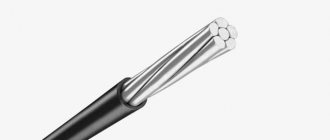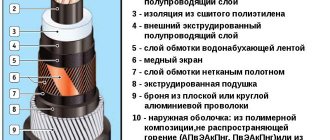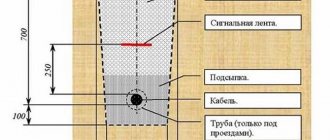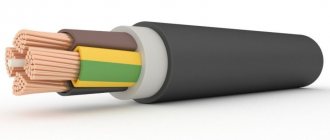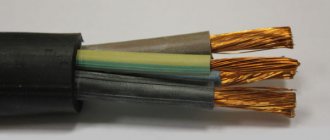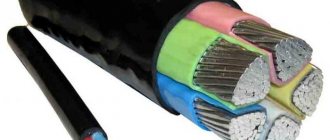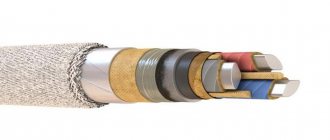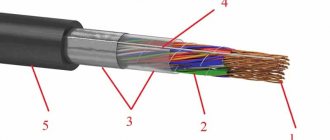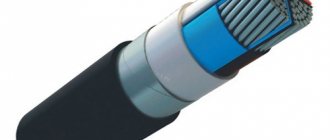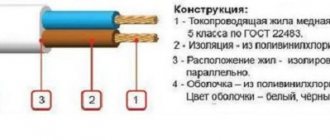Building a home electrical network is accessible to anyone who has mastered a school physics course. Agree, the services of an electrician will not be cheap, but independent experience will always come in handy.
But amateur craftsmen usually face a problem regarding the choice of cable. What type of wiring is the most reliable and safe? The answer is simple - standard VVG cable, designed for assembling AC circuits.
If you decide to do your own home wiring, we suggest you familiarize yourself with useful information. We will analyze what a VVG cable is: decoding the letter symbols and reviewing the characteristics will help you choose the optimal modification.
Purpose and application features
The VVG cable is designed for transmission and distribution of electricity in stationary installations with a frequency of 50 Hz and operating voltage from 660 to 1000 V.
It is used for the purpose of installation, repair or complete replacement of wiring in residential and industrial buildings. Reinforced types are suitable for installation in fire hazardous, damp, underground areas.
VVG is the best electrical wiring option for the home. Factory-made products fully meet certification requirements, are fire and electrical safe, are distinguished by their low price and variety of types.
In addition to popular types designed for a frequency of 50 Hz, there are modifications for use at 100 Hz. If necessary, you can select wires for a 1-phase or 3-phase circuit, for installation inside and outside buildings.
If the wire is pulled outside the house, it needs additional protection - a metal sleeve, a durable cable channel, a special tray or a corrugated pipe.
For wiring in the ground, shaft, or collector, protection must be maximum, since the product has no armor at all. Especially for difficult installation conditions, there is another option - armored cable VBBShV.
Electrical wiring in a wooden house also requires protection in the form of a metal hose, non-flammable channel or metal pipe.
terms of Use
Before purchasing wiring according to the marked marking, you should familiarize yourself with some of the necessary conditions for installing wires of this type. For high-quality installation and long-term operation, the following rules must be observed:
- It is more advisable to lay the wiring at an ambient temperature of at least -15 °C (at lower temperatures the shell will be rigid and will need to be heated).
- Operation is possible at temperatures ranging from -50 °C to +50 °C (when installed outdoors, the wiring is hidden under additional protection from ultraviolet rays).
- The permissible heating of conductors during a short circuit ranges from +160 °C to +250 °C, depending on the manufacturer, during normal use - +70 °C, during overload periods - +90 °C.
- The fire resistance of cables marked VVG must be at least 180 minutes.
The above parameters depend not only on the specific type, but also on the product manufacturers.
Before purchasing a product, you must read the technical data sheet of the product (located from the seller).
Decoding of letter designations and types of VVG
The type of cable is easy to determine, even if it is packaged in a coil: the appropriate marking is applied to the surface of the outer insulation. Among the many alphanumeric characters and the type of cable. What do these generally accepted letter combinations mean?
VVG is a copper cable, each core of which is protected by a polyvinyl chloride sheath, and the outer insulation is also made of PVC. “G” - lack of armor or other durable shell for use in aggressive conditions.
Literally it stands for this:
- “B” – vinyl;
- “B” – vinyl;
- "G" - naked.
Both the cores and the sheaths are made of various materials with special technical characteristics. Based on this, various types of VVG cable are distinguished.
Copper wire sample. According to the current requirements of the PUE, aluminum cannot be used for the manufacture of conductors with a cross-section of less than 16 mm²; larger ones are still allowed - for reasons of economy and lighter weight
Accordingly, copper products are ideal for home use.
The most popular types of power wires.
VVGng – non-flammable/low flammability. Fire resistance is due to the addition of non-flammable ingredients to the plastic. If a fire occurs, the wiring will not burn itself or be ignited by adjacent cables.
VVGng LS is a type of non-flammable cable with low gas and smoke emissions. LS stands for Low Smoke.
VVGng LSLTx – LTx – Low Toxic (low level of toxicity) is added to the above qualities. When ignited, no hazardous substances are released from the shell. The most secure cable of this type is in demand in preschool and educational institutions, clinics and hospitals.
VVGng HF - the shell does not contain halogen substances, such as chlorine, etc. HF - Halogen Free (without halogens).
VVGng FRLS is a cable for group installation, its feature is maximum fire resistance. FRLS – Fire Resistance (fire resistant). Even within 3 hours the cable will not ignite or smoke thanks to the mica shell.
VVG-Png – flat wire with 2-3 cores, non-flammable. Sometimes it is more convenient to connect a flat cable with other wires or place it in baseboards or boxes.
All wires that do not have the letter “p” in the name have a round cross-section, regardless of the number of conductors located inside and the type of insulation
To install home electrical circuits, you do not need to purchase expensive types with additional protection.
Usually they use budget cable VVG, which is most suitable for interior work, or VVGng if group installation is planned.
What to look for when choosing
Manufacturers may underestimate the cross-section of individual conductors in the overall insulation. State regulations say that this can be done if the overall resistance does not change. But thin conductors heat up more and create a fire hazard.
When choosing, take into account the following characteristics:
- diameter and weight;
- rated current value;
- short-circuit current value;
- resistance, power;
- design of cores and cables.
If it is indicated that the product is manufactured in accordance with the requirements of technical specifications and not GOST, a certificate of conformity is required , issued by a licensed company. Unscrupulous manufacturers produce wires with a thin sheath, which creates a risk of breakdown on the housing or elsewhere.
Number and shape of conductors
All cables can be divided into two categories - single-core and multi-core.
Diagram of a three-core VVG cable. Each copper core is protected by a color-coded PVC sheath, and the entire bundle is protected by another outer insulation
The number of conductors under the outer sheath of the cable is from 2 to 6, while the cross-section of the cores can be any - from 1.5 to 250 mm².
For home electrical networks, products with neutral and grounding conductors are more often used. The insulation of the first is painted blue, the second is yellow-green.
On the market, in addition to round, there are also segmented shapes of conductors. It is advisable to use it in the manufacture of large-diameter cables for compactness, so that there are no voids between the individual cores.
If the current-carrying conductors have a round shape, all the free space between them can be filled with plastic compound - a material whose properties resemble cable insulation
In VVG products of small diameter - up to 25 mm - internal filling may not be used.
Fire safety markings
A complete description of the cable properties can be compiled using the main and additional markings. For VVG cable, decoding begins with the presence or absence of the letter “A” at its beginning. If it is not there, then the cable is copper, otherwise it is aluminum. The letters “B” indicate the insulation material: on the cores and on the outside - in both cases polyvinyl chloride is used. The last letter “G” indicates the absence of an external armored coating - such a cable, with a soft sheath, is considered bare. The letter “p”, if it appears after the letters VVG, means that the cable is flat - the cores in it are laid in a row, and not twisted together. There are also the designations “T” and “UHL”, which indicate tropical insulation performance or designed for temperate and cold climates.
In addition to the main letters, the cable marking may contain additional ones, indicating that the fireproof properties of the insulation differ from the standard ones.
- ng - shows that if wires are laid in one cable channel, if one of the wires is significantly overheated, the insulation will not ignite, but will only smolder, protecting adjacent wires from ignition;
- ng-ls – insulation when smoldering releases a reduced amount of smoke and carbon monoxide into the air;
- ng-hf - even if the insulation catches fire, a minimal amount of harmful resins and gases will be released into the air, which can have a corrosive effect;
- if the prefix “fr” is added to the listed designations, this indicates the fire resistance of the insulation, which is achieved by using mica-containing windings.
Wires can be numbered or color-coded, and manufacturers use complete painting of the wire core and partial painting - when only part of the insulation is colored, usually a strip 1 mm wide. If there are two current-carrying wires, then their color necessarily includes a blue neutral wire, and if there are three or more, then a yellow-green ground wire.
Technical characteristics of VVG cable
To correctly determine the purpose of the wire, you need to clarify its technical and operational characteristics, which relate to design features, dimensions and weight, and physical characteristics. Let's consider the main selection criteria.
#1 – design features
Considering the many modifications, you should choose the most successful one from all the options presented on the market. And to do this you need to compare the characteristics of different products.
Suppose the choice is between VVG and VVGng - which one is better suited for kitchen electrical wiring? Both are copper, three-core, “sealed” in a PVC sheath. It is impossible to tell the difference by appearance.
The secret of the VVGng cable’s resistance to fire lies in the composition of the protective sheath. Under any operating conditions, it is less susceptible to combustion than VVG insulation
Considering that the kitchen is usually crammed with electrical household appliances, it is better to play it safe and choose an option with a non-flammable braid. Although for single wires with a small load a standard 3-core VVG 2-2.5 mm cable is suitable, but for group installation it is better to take a product in non-flammable insulation.
Is it possible to use other types of wires, for example, VVGng LS? Yes, but this is not always advisable. Cables with reduced smoke emission are more complex in design: they are multi-core, consist of twisted round or segment conductors, filled with plastic, one wire may have a smaller cross-section.
The option marked LS is usually used in industrial workshops or other premises where there is a real risk of accidental fire.
#2 – cross section
For domestic use, a cable with a cross-section of each core from 1.5 to 3.5 mm² is used, for industrial purposes - up to 250 mm². Products with a small cross-section are always on sale; modifications with parameters above 35 mm² are usually delivered to order.
The number of cores and their cross-section are usually written immediately after the name of the cable, for example: VVG 3x1.5 or VVGng 4x2.5. This is a common marking
If you are offered a cable with one conductor smaller in diameter, that’s okay. Most likely, this is a grounding conductor, which is usually enclosed in a yellow-green sheath.
Whether there is a core with a smaller diameter than the rest inside the outer sheath can also be determined by the markings. Usually the digital designation “+1” is assigned to the name. Example of a name: VVGng 3x2.5 mm²+1 – that is, 3 cores with a cross-section of 2.5 mm² plus one step smaller, 1.5 mm².
But more often than not, everyone selects conductors of the same cross-section, which is convenient for connecting them to electromechanical installations and to each other in junction boxes
Both “single-gauge” products and wires with a core of unequal cross-section are classified as standard and are manufactured in accordance with GOST.
#3 – parameters of long-term permissible current
When choosing a cross-section, the main role is played not so much by the resistance of the conductors, but by the magnitude of the electric current, the maximum permissible in the circuit.
It depends on the following factors:
- installation method;
- number of cores;
- cross section of each core.
The installation method means open or closed (in grooves) installation.
The table shows the dependence of the value of the continuous permissible current on the number of conductors in the cable and their cross-section - from 1.5 to 35 mm²
We remind you that VVG wires are used for AC electrical wiring from 0.66 to 1 kW.
#4 – VVG cable weight
The cable is sold by manufacturers and intermediary companies, which are construction and electrical materials stores and specialized companies. Various modifications with a cross-section of 1.5-2.5 mm² are sold in coils and sections from 10 to 100 m.
It is clear that the weight will directly depend on both the cross-section and the footage. It is calculated that the mass of a coil of VVGng wire 1 km long, depending on the cross-section, can weigh 30, 10, or 250 kg.
A 100-meter bay of 3-core VVG cable with a cross-section of 2.5 mm² weighs a little more than 13.5 kg.
#5 – other operational and physical indicators
When purchasing a coil or a piece of cable, you can inquire about other technical characteristics, which are necessarily indicated in the accompanying documentation.
The following values are typical for VVG cable:
- operating temperature – -50°С – +50°С; max temperature – up to +70 °C (with long-term use); emergency temperature – +80 °C (during short-term overheating);
- the minimum temperature value for installation is -15 °C or higher;
- relative air humidity – 98% (at t +35 °C);
- climatic version - T/UHL (tropical or moderately cold climate, respectively);
- service life – 30 years, warranty – up to 5 years;
- bending radius - at least 7.5 outer diameters for multi-core products, 10 outer diameters for single-core products.
Coils should be stored indoors for a maximum of 10 years, outdoors (under a canopy) for no more than 5 years. The absence of a canopy reduces the shelf life to 2 years.
In the tables you can familiarize yourself with the remaining parameters: insulation thickness and core resistance. Standard values for cables of various sizes are indicated.
Recommendations for using VVGng at home:
- lighting contours – 3x1.5;
- socket groups – 3x2.5;
- connection of powerful equipment (boiler, stove, dishwasher) - 3x4.
The latest version of the cable can withstand a load of up to 8 kW - this is enough to build the most energy-intensive kitchen network.
Power calculation table
When choosing a cable, you need to know what the permissible load of each wire section is. Add up the power of all consumers on the selected power line, take a margin of at least 30% and select the required cable cross-section in accordance with the table.
| Conductor cross-section, sq.mm | Copper conductors | |||
| 220 V | 380 V | |||
| current, A | power, kWt | current, A | power, kWt | |
| 1,5 | 19 | 4,1 | 16 | 10,5 |
| 2,5 | 27 | 5,9 | 25 | 16,5 |
| 4 | 38 | 8,3 | 30 | 19,8 |
| 6 | 46 | 10,1 | 40 | 26,4 |
| 10 | 70 | 15,4 | 50 | 33 |
| 16 | 85 | 18,7 | 75 | 49,5 |
| 25 | 115 | 25,3 | 90 | 59,4 |
| 35 | 135 | 29,7 | 115 | 75,9 |
| 50 | 175 | 38,5 | 145 | 95,7 |
| 70 | 215 | 47,3 | 180 | 118,8 |
| 95 | 260 | 57,2 | 220 | 145,2 |
| 120 | 300 | 66 | 260 | 171,6 |
The disadvantage of VVG cables is their relatively high price, so it is advisable to use them to connect powerful electricity consumers, for example, electric stoves, hobs or instantaneous water heaters.
How to choose
The first step is to select the appropriate wire cross-section. There are special tables that indicate what cross-section of aluminum/copper conductor is required for a particular load. Masters use the usual formula:
- For example, a load of 8 kW is taken. A copper wire cross-section of 1 mm2 passes through 10A or 2.2 kW;
- therefore, a load of 8 kW in amperes will be equal to 36 A (load = 8 kW / 220V), therefore a cable with a cross-section of 4 mm2 can be used.
This formula is most suitable for wires whose cross-section does not exceed 6 mm2. For thicker cables, you need to use the table of “permitted current loads”.
With the same load, the cross-section of the copper wire should be approximately 30% smaller than that of aluminum.
Aluminum conductors
Laying methods
The VVG cable can be used in the construction of various objects, as well as in underground trenches.
The laying method directly depends on the specific purpose. The conductor can be laid on various surfaces consisting of non-combustible materials. These include concrete, plaster, brick or plaster. The VVG cable can be laid openly under a variety of suspended structures. Reception of scrap cable. A prerequisite is the exclusion of any mechanical influences. If there is a possibility of damage to the conductor, you need to think about additional protection. Often, special channels, tubes, metal or corrugated hoses are used for this.
The most popular is the hidden method. It is often used in residential premises when the cable is laid under plaster. First you need to make grooves in the walls, and then treat the product with cement plaster. In such situations, the possibility of mechanical impacts is eliminated, so there is no need to use additional protection. The only exception is when the wire is laid in wooden buildings. This option can be used in structures made of fireproof materials, for example, in pipes.
There is no wire that can be laid underground without the use of special protective elements. This is due to the fact that the cable needs to be preserved for a long period, but it itself is not equipped with built-in protection. Because of this, certain elements of protection against mechanical damage are used. In most cases they are sealed boxes.
Open position
If you study the technical parameters of the cable, you can conclude that installation is allowed in surfaces made of difficult-to-flammable or non-flammable materials, for example brick, concrete, gypsum or plaster. In an open way, VVG wire can be laid under various suspended structures, such as cables and the like. In this case, the gasket must be very reliable.
Any mechanical influences should be excluded. If the cable may be damaged, additional protection must be provided. Usually, special channels, metal hoses, corrugated hoses or tubes are used for this purpose. Protection is installed if the open installation method is carried out on flammable objects, built, for example, from wood.
Hidden option
This installation method is the most popular and is used in residential premises. The wire is usually laid under the plaster. Until this point, grooves are made in the walls, and after that the cable is covered with plaster and cement. In this case, mechanical damage is excluded, and therefore there is no need to apply additional protection. The exception is when the cable is laid in wooden houses. Hidden gasket can be used in various fireproof materials, for example, in pipes.
Location underground
No type of cable can be laid underground without the use of special protection. This is because the wire needs to be preserved for a long time, but it itself is not equipped with built-in protection. That is why protective measures are taken against various mechanical damages. For underground installation, sealed boxes are used.
Structural basis of the cable product
The design of the cable or electrical wires determines the technical and operational characteristics of the product. Actually, the design of cable or wire products is, in most design variations, a fairly simple technological approach.
Classic version:
- Cable insulation.
- Core insulation.
- Metal core – solid/bundled.
A metal core is the base of a cable/wire through which electric current flows. The main characteristic, in this case, is the throughput, determined by the cross-section of the core. This parameter is influenced by the structure - solid or bunched.
Such a property as flexibility also depends on the structure. In terms of the degree of “softness” of bending, stranded (bundled) conductors are characterized by better properties than single-core wires.
The structural design of the current-carrying part is traditionally represented by “beam” or “solid” (monolithic). This has implications, for example, in relation to flexibility properties. The picture shows stranded/bundled wire typeThe cores of cables and wires in electrical practice, as a rule, have a cylindrical shape. At the same time, it is rare, but there are several modified shapes: square, oval.
The main materials for the manufacture of conductive metal cores are copper and aluminum. However, electrical practice does not exclude conductors whose structure contains steel cores, for example, a “field” wire.
While a single electrical wire is traditionally built on a single conductor, a cable is a product where several such conductors are concentrated.
